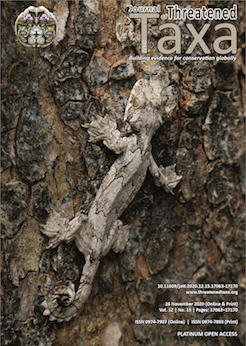A new country record of Smooth-backed Gliding Gecko Gekko lionotum (Annandale, 1905) (Squamata: Gekkonidae) from Bangladesh
DOI:
https://doi.org/10.11609/jott.6559.12.15.17161-17164Keywords:
Gekko lionotum, Gekkonidae, lizard, Gliding gecko, PtychozoonAbstract
We report a new record in Bangladesh of the Smooth-backed Gliding Gecko Gekko lionotum Annandale, 1905, recorded from a biodiversity hotspot area at Bandarban located at the southeastern side of the country. A freshly dead specimen was collected and donated to the Padma Bridge Museum for further identification and display. We confirmed identification by comparing morphometric and meristic characteristics with literature records. Gekko lionotum is distributed in Myanmar and northeast India, but was not recorded previously from Bangladesh. The camouflaging color pattern and cryptic lifestyle of this species, together with and absence of research efforts, likely account for the lack of previous records for this species in Bangladesh territory.
References
Brown, R.M. (1999). New species of parachute gecko (Squamata: Gekkonidae: genus Ptychozoon) from northeastern Thailand and central Vietnam. Copeia 990–1001. https://doi.org/10.2307/1447974
Brown, R.M., J.W. Ferner & A.C. Diesmos (1997). Definition of the Philippine Parachute Gecko, Ptychozoon intermedium Taylor 1915 (Reptilia: Squamata: Gekkonidae): redescription, designation of a neotype, and comparisons with related species. Herpetologica 53(3): 357–373.
Grismer, L.L., P.L. Jr. Wood, M.K. Thura, M.S. Grismer, R.M. Brown & B.L. Stuart (2018). Geographically structured genetic variation in Ptychozoonlionotum (Squamata: Gekkonidae) and a new species from an isolated volcano in Myanmar. Zootaxa 4514(2): 202–214. https://doi.org/10.11646/zootaxa.4514.2.4
International Resources Group (IRG) (2012). Integrated Protected Area Co-Management (IPAC): State of Bangladesh’s Forest Protected Areas 2010. Nishorgo Network, USAID, 35pp.
The IUCN Red List of Threatened Species (IUCN) (2018). Ptychozoon lionotum: e.T177831A103308608. Downloaded on 30 September 2020. https://doi.org/10.2305/IUCN.UK.2018-2.RLTS.T177831A103308608.en
Nishat, A., S.I. Huq, S.P. Barua, A.H.M.A. Reza & A.M. Khan (2002).Bio-ecological zones of Bangladesh. The World Conservation Union (IUCN), Dhaka, Bangladesh, 141pp.
Pawar, S.S. & S.Biswas (2001). First record of the Smoothbacked Parachute Gecko Ptychozoonlionotum Annandale, 1905 from the Indian Mainland. Asiatic Herpetological Research 9: 101–106.
Uetz, P., P. Freed & J. Hošek (eds.) (2020). The Reptile Database. http://www.reptile-database.org, accessed on 25 September 2020.
Wood, P.L., X. Guo, S.L. Travers, Y.C. Su, K.V. Olson, A.M. Bauer, L.L. Grismer, C.D. Siler, R.G. Moyle, M.J. Andersen & R.M. Brown (2020). Parachute geckos free fall into synonymy: Gekko phylogeny, and a new subgeneric classification, inferred from thousands of ultraconserved elements. Molecular Phylogenetics and Evolution 146: 106731. https://doi.org/10.1016/j.ympev.2020.106731
Published
Versions
- 26-11-2020 (2)
- 26-11-2020 (1)
Issue
Section
License
Copyright (c) 2020 M. Rashedul Kabir Bhuiyan, M. Fazle Rabbe, Mohammad Firoj Jaman, Ananda Kumar Das, Samiul Mohsanin

This work is licensed under a Creative Commons Attribution 4.0 International License.
Authors own the copyright to the articles published in JoTT. This is indicated explicitly in each publication. The authors grant permission to the publisher Wildlife Information Liaison Development (WILD) Society to publish the article in the Journal of Threatened Taxa. The authors recognize WILD as the original publisher, and to sell hard copies of the Journal and article to any buyer. JoTT is registered under the Creative Commons Attribution 4.0 International License (CC BY), which allows authors to retain copyright ownership. Under this license the authors allow anyone to download, cite, use the data, modify, reprint, copy and distribute provided the authors and source of publication are credited through appropriate citations (e.g., Son et al. (2016). Bats (Mammalia: Chiroptera) of the southeastern Truong Son Mountains, Quang Ngai Province, Vietnam. Journal of Threatened Taxa 8(7): 8953–8969. https://doi.org/10.11609/jott.2785.8.7.8953-8969). Users of the data do not require specific permission from the authors or the publisher.





